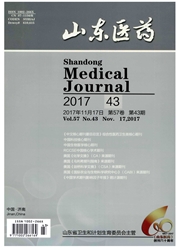

 中文摘要:
中文摘要:
目的 观察原癌基因蛋白Raf-1对裸鼠人乳腺癌细胞移植瘤上皮间质转化(EMT)的影响,并探讨其可能的机制.方法 将20只裸鼠随机分成A、B组,每组10只,分别侧腹部皮下注射对数生长期的MCF-7和MCF-7Raf-1细胞2×106个,建立裸鼠移植瘤模型.12周后处死裸鼠,原代培养裸鼠移植瘤细胞.采用Western blot法检测EMT的上皮细胞标志物E-cadherin、β-catenin和间质标志物vimentin,以及AURKA、总正丝裂原活化蛋白激酶(tMAPK)及磷酸化MAPK(p-MAPK).采用AURKA抑制剂处理MCF-7Raf-1移植瘤细胞48、72 h,采用Western blot法检测E-caherin、β-catenin、vimentin蛋白.结果 肿瘤细胞移植后4、8、12周,B组移植瘤体积均大于A组(P均<0.05);与A组比较,B组移植瘤细胞E-caherin、β-catenin蛋白相对表达量降低,vimentin、p-MAPK、AURKA蛋白相对表达量增加,P均<0.05;与AURKA抑制剂处理前比较,B组处理后48、72 h移植瘤细胞E-caherin、β-catenin蛋白相对表达量增加,vimentin蛋白相对表达量降低,P均<0.05.结论 Raf-1过表达使乳腺癌细胞增殖能力显著增强,导致了AURKA高表达,发展了EMT表型;针对MAPK和AURKA信号通路的分子靶向治疗,有助于抑制乳腺癌细胞的增殖、侵袭和转移.
 英文摘要:
英文摘要:
Objective To observe the effects of proto-oncogene protein Raf-1 on the epithelial-mesenchymal transition (EMT) of human breast cancer xenografts in nude mice, and to investigate the possible mechanism. Methods Twenty nude mice were divided into group A and B ( 10 in each group). 2 × 10^6 MCF-7 and MCF-7Raf-1 breast cancer cells were subcutaneously injected into group A and B respectively as xenografts. Primary cancer cells were cultured" from xenograft tumors after nude mice were sacrificed 12 weeks later. Western blotting was applied to detect E-cadherin, β-catenin, vimentin, AURKA, total mitogen-activated protein kinase (tMAPK) and phosphorylated mitogen-activated protein kinase (p- MAPK). AURKA inhibitor MLN8237 was used to treat the MCF-7Raf-1 xenograft tumors for 48 and 72 h, and E-cadherin, β-catenin and vimentin proteins were detected by Western blotting. Results Compared with group A, group B xenografts showed the greater tumor volume and rapider growth at 4, 8 and 12 weeks ( all P 〈 0.05) ; compared with those of group A, E-cadherin and β-catenin expression decreased, whereas the protein expression of vimentin, p-MAPK and AURKA increased in group B (all P 〈 0.05 ) ; in group B, compared with that before treatment, E-cadherin, β-catenin protein expression increased and vimentin protein expression decreased after being treated by AURKA inhibitor for 48 and 72 h, respectively, ( all P 〈 0.05). Conclusion Raf-1 overexpression enhances proliferation ability, which leads to the high expression of AURKA and develops the EMT phenotype. Therefore, the molecular target treatment for MAPK and AURKA pathways could be helpful to inhibit the proliferation, invasion and metastasis of breast cancer.
 同期刊论文项目
同期刊论文项目
 同项目期刊论文
同项目期刊论文
 Clinical significances and prognostic value of cancer stem ‐ like cells markers and vasculogenic mim
Clinical significances and prognostic value of cancer stem ‐ like cells markers and vasculogenic mim Hypoxia promotes vasculogenic mimicry formation by inducing epithelial–mesenchymal transition in ova
Hypoxia promotes vasculogenic mimicry formation by inducing epithelial–mesenchymal transition in ova Wnt5a promotes vasculogenic mimicry and epithelial-mesenchymal transition via protein kinase Cα in e
Wnt5a promotes vasculogenic mimicry and epithelial-mesenchymal transition via protein kinase Cα in e Subpopulations of uPAR(+) contribute to vasculogenic mimicry and metastasis in large cell lung cance
Subpopulations of uPAR(+) contribute to vasculogenic mimicry and metastasis in large cell lung cance ZEB2 promotes vasculogenic mimicry by TGF-β1 induced epithelial-to-mesenchymal transition in hepatoc
ZEB2 promotes vasculogenic mimicry by TGF-β1 induced epithelial-to-mesenchymal transition in hepatoc CD133+ cells with cancer stem cell characteristics associates with vasculogenic mimicry in triple-ne
CD133+ cells with cancer stem cell characteristics associates with vasculogenic mimicry in triple-ne The in - vitro spheroid culture induces a more highly differentiated but tumorigenic population from
The in - vitro spheroid culture induces a more highly differentiated but tumorigenic population from USP44+ Cancer Stem Cell Subclones Contribute to Breast Cancer Aggressiveness by Promoting Vasculogen
USP44+ Cancer Stem Cell Subclones Contribute to Breast Cancer Aggressiveness by Promoting Vasculogen Linearly Patterned Programmed Cell Necrosis Induced by Chronic Hypoxia Plays a Role in Melanoma Angi
Linearly Patterned Programmed Cell Necrosis Induced by Chronic Hypoxia Plays a Role in Melanoma Angi 期刊信息
期刊信息
